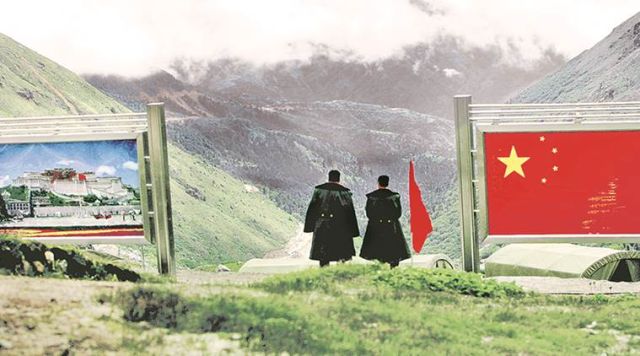
by admin | May 25, 2021 | World
 By Gaurav Sharma,
By Gaurav Sharma,
Beijing : China on Friday said it will keep building infrastructure in Doklam and India has no business to comment on construction activity on Chinese territory.
Some satellite images purportedly show massive infrastructure build-up in Doklam, as close as 81 meters to the point of face-off between Indian and Chinese troops in the disputed plateau last year.
“I don’t know who offers such kind of photos. I don’t know the detailed information,” Chinese Foreign Ministry spokesperson Lu Kang said when asked about the images.
“You must be quite clear. Donglong (Doklam) always belongs to China and is always under China’s effective jurisdiction. There is no dispute in this regard,” Lu said.
“China is exercising its sovereignty in its own territory. It’s legitimate and justified. Just as China will not make comments about Indian construction of infrastructure on India’s territory, we hope other countries will not make comment on China’s construction of infrastructure on its territory,” Lu said.
India and Chinese troops were locked in a 73-day stand-off at Doklam, which is claimed by Bhutan.
The face-off began when the Indian military halted road building by the Chinese at Doka La in the region which is very close to India’s highway.
Even as both sides resolved the crisis by retreating from the point of face-off in August, news reports suggested that China was busy building infrastructure to fortify its position in the region.
—IANS
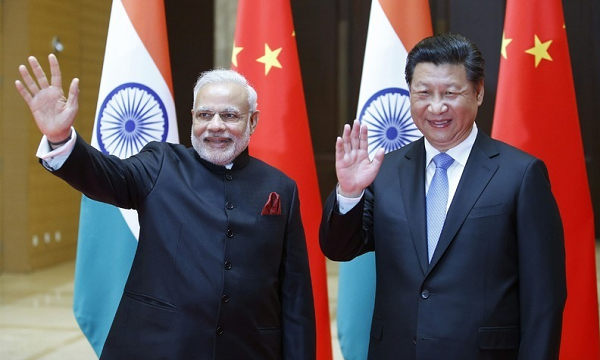
by admin | May 25, 2021 | News, Politics
 By Gaurav Sharma,
By Gaurav Sharma,
Beijing : China on Monday expressed anger over Indian Army chief Bipin Rawat’s recent remarks, saying such “unconstructive” comments defy the consensus to maintain peace and would rather hurt it.
At a press conference last week, Gen Rawat said it was time India shifted its focus from the western border with Pakistan to its northern frontier with China, which could send back troops again to the point of face-off in Doklam plateau.
He also said that India needed to check China’s growing assertiveness in the neighbouring countries in the South Asia region.
Chinese Foreign Ministry spokesperson Lu Kang said the remarks would disturb peace, which both countries were trying to restore after a military stand-off last year.
“Last year, India-China relations have witnessed some twists and turns but Chinese President Xi Jinping and Prime Minister Narendra Modi during their meeting on the sidelines of the BRICS meeting last September reached a consensus to bring the ties back on track,” Lu said.
“Recently, the two sides enhanced dialogue on consultations and bilateral relations have shown sound momentum of improvement and development.
“Under such background, the unconstructive remarks by the Indian senior officials not only go against the consensus reached by the two heads of state and do not conform to the efforts made by the two sides to improve and develop bilateral relations.
“It cannot help to preserve tranquillity and peace in the border areas,” Lu added.
Lu said India should stick to the consensus reached between Modi and Xi and “refrain from doing things which may complicate the situation. This serves the common interest of the whole region and the interest of the Indian side.”
Briefing the media, Gen Rawat had said the Chinese troops retreated from Doka La in Doklam possibly due to the harsh winter and could return to the point of the face-off.
Indian and Chinese troops were locked in an over two-month stand-off at Doka La in Doklam plateau over road construction by China.
The borders of India, China and Bhutan meet at Doka La in Doklam, which is claimed by Beijing and Thimpu.
India’s objection to the road was Doka La’s proximity to its highway that connects its northeast with rest of the country. Both armies retreated from the point of face-off on August 28.
Asked which particular remark of Gen Rawat’s China has taken exception to, Lu said: “I have made myself clear. If the senior official according to the report referred to Donglang (Doklam), I think you are clear about our position – Donglang belongs to China and has always been in the effective jurisdiction of China.
“The China border troops patrolling and stationed in the area are exercising our sovereignty rights. We hope the Indian side has learned the lessons of history and will avoid similar accidents to take place again.
“If he refers to the situation in the whole India-China boundary, I have also said that last September the two heads of state have reached important consensus during the Xiamen summit. Both sides have maintained effective communication since then.
“The aim is to enhance strategic mutual trust and create enabling atmosphere for strategic communication. Recently the bilateral relations have shown positive momentum.
“On such background, the official mentioned by you made such kind of remarks that go against the consensus of the states and do not conform to the general trend of improvement of bilateral relations. We believe such kinds of remarks are not conducive to maintaining peace and tranquility in border areas.”
—IANS
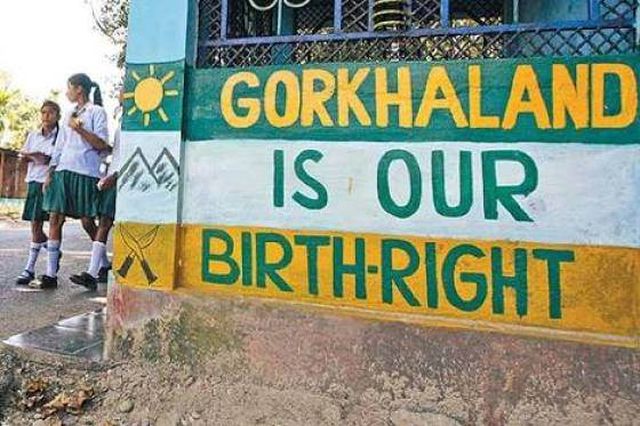
by admin | May 25, 2021 | Opinions
 By Saeed Naqvi,
By Saeed Naqvi,
Darjeeling, Thimphu, Gangtok and Siliguri are a tight cluster on any map even in a large Atlas. Because of the recent standoff with China over Doklam, the strategic importance of the area, the saliency of the Siliguri corridor, cannot be overlooked. Is New Delhi taking an interest in the demand for a Gorkha homeland from this perspective?
My taxi has to wait outside Kurseong Toy Train station, on the way from Siliguri to Darjeeling, because a march by agitating Gorkha women will not let us pass. Violence in this sensitive area could be very unsettling. Angry women bang on the bonnet of my car and jeer at the Gorkha driver: “Have you joined the Bengalis?” It is a threatening query.
Similar bandhs and marches have brought life to a grinding halt for the past three months — and continuing. There are, of course, cunning leakages — a few chicken being sold here, some vegetables there. But this private enterprise disappears at the sight of approaching marchers.
Contrary to what one might imagine, this sporadic enterprise does not demonstrate a weakening of the popular will. In fact it helps people a bit and enables them to bear the suffering a little longer. It supplements the agitation.
Clearly, Gorkhaland is not likely to be conceded in a hurry. What then have the leaders of the Gorkha Janmukti Morcha (GJM) promised the people? What spell have they cast on them because of which the people have diligently pursued these marches, street-corner meetings and picketing outside offices in an atmosphere of total bandh (bar the contrived leakages). Schools, hotels, restaurants and shops are shut and labourers on all the 88 tea plantations have struck work and are, therefore, beginning to depend on packets of food some well meaning people are arranging.
No one quite knows the preferred game plans of the plantation owners. The gossip is that they would now like the strike to continue till December and so they are not obliged to pay the workers three months’ wages (for the period when the plantations have been closed) plus bonus for puja holidays.
The inordinate extension of the bandh is causing all the leaders of the Gorkha Movement Coordination Committee to miss heart beats with alarming frequency.
West Bengal Chief Minister Mamata Banerjee, who is always inclined to see agitations, however legitimate, as an affront to her, has slapped countless cases against leaders, including Bimal Gurung, President of GJM, the main political party.
This has given him a respectable reason to run away from Darjeeling and hide in Sikkim. The cases, in other words, are a godsend. Had there been no cases, how would the leaders escape the wrath of the people who are on this occasion truly mobilised? They must be shown some movement towards Gorkhaland. This “movement” is proving elusive even by inches, leave alone feet and yards.
Since all leaders in the coordination committee were pushed from the precipice into a total bandh by the GJM leader Bimal Gurung, they are privately cursing him but are unable to publicly say anything that would make their resolve for Gorkhaland look weaker. But some of them are keeping a sly eye on any escape route which they can sell to the agitating populace as an advance towards their cause.
The situation is custom made for Mamata Banerjee, who is desperate to fill whatever political spaces she can with her TMC before the BJP does. If she can divide the leadership with promises of development plus a dialogue with the Centre on “the people’s demand”, perhaps a “dissident” faction can then be mobilised as a vehicle for the TMC.
There is a very big “perhaps”. Why would West Bengal politicians and bureaucrats ever loosen their grip on the hill station, the toy train which their children enjoy so much during the summer vacation. There is nothing more popular internationally and which Bengal claims as its own — Tagore and Darjeeling tea.
New Delhi habitually goes into a freeze when confronted with something new, particularly where strategic concerns are involved. Gorkha/Nepali speaking people from Nepal, Sikkim and Bhutan are already keeping New Delhi busy. Gorkhaland would be a new distraction.
A strong card the Gorkhas can play concerns the military. There are thousands of Gorkhas in the Army. It is not uncommon to run into a soldier with heroic stories of the Kargil war. These soldiers would be perfectly justified in seeking home leave to see the families who have suffered a bandh for three months. Thousands seeking leave at once? It is a sensitive pressure point.
The straightforward political game the BJP can play to endear themselves to the Gorkhas is by opening up debate on something less than Gorkhaland — say, a Union Territory. Gorkhas would accept it. Darjeeling would come directly under New Delhi. Mamata would of course throw a ginger fit.
After a meeting of Gorkha leaders with Mamata on August 29, Vinay Tamang, Joint Secretary of the Morcha, and Anit Thapa, member of the Executive Committee, took the leaders and the agitators by surprise by asking them to end the bandh because positive but unidentifiable developments were expected by September 12. By that time the next round of meetings with Rajnath Singh and Mamata would have been held, they said. Well, September 12 too has come and gone and there is no sight of the bandh coming to an end.
Little wonder most of the Gorkha leaders, Bimal Gurung, Vinay Tamang, Anit Thapa, are on a rapidly declining popularity graph.
Bimal Gurung’s political career was launched by his opening numerous fan clubs for a Gorkha singing sensation, Prashant Tamang, who won the 2007 Indian Idol, a reality show. Prashant won in the third week of September. On October 7, Bimal Gurung had launched the GJM.
Impulsively, he leapt into the bandh when Mamata wanted Bengali to be inserted in the three language formula. Later she withdrew her word. But by that time the GJM and the coordination committee of other Hill parties were fairly advanced on a high-wire act. An endless bandh was on.
The leader whose graph is up is R.B. Rai, twice MP, President of the Communist Party of Revolutionary Marxist, Central Committee. He is universally accepted as politically savvy and an incorruptible and respected leader. He believes “tripartite talks” are a promising enough outcome to end the bandh. Apparently, Rajnath Singh has dropped hints that New Delhi-Kolkata- Darjeeling tripartite talks on Gorkhaland are possible. But will Mamata agree?
Rai is cross with the amateurishness of Bimal Gurung for playing “the ultimate card of a total bandh without having a back-up plan. We should have started with Mohalla marches, struck work for a few hours, tested the political reaction in Kolkata and New Delhi, planned jail bharo andolans, gauged the plantation workers capacity to survive long strikes without wages. And so on.”
There was no plan, he laments. It is a fruitless bandh but it can only be called off when people see some real promise, he says.
So, until God comes riding a thunderbolt by way of a solution, Gorkha leaders are condemned to remain suspended on the last rung of a very high staircase leading to nowhere.
(Saeed Naqvi is a commentator on political and diplomatic affairs. The views expressed are personal. He can be reached on saeednaqvi@hotmail.com)
—IANS
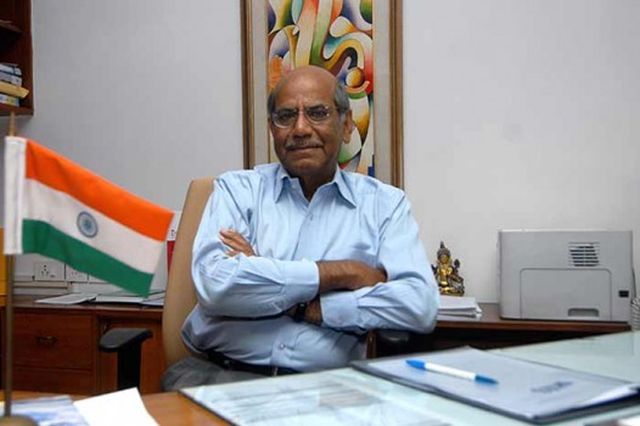
by admin | May 25, 2021 | Interviews

Shyam Saran
By Saket Suman,
New Delhi : The areas of convergence between India and China are diminishing while those of confrontation have become “more salient”, former Foreign Secretary Shyam Saran says, adding that New Delhi had “judiciously” handled the two-month standoff on the Doklam plateau.
He also says that India and Pakistan had almost come to an agreement on demilitarising the Siachen glacier and mentions a “missed opportunity” to solve the Sir Creek dispute in Kutch.
“There are areas where India and China have convergent interests, but at the same time there are very divergent interests that are continuing as disputes between the two countries because of the unresolved border disputes. Essentially, over the last several years we have followed a strategy of building upon the areas of convergence with China but at the same time confronting China whenever our interests are threatened.
“If we compare the Indo-China relationship from the time I was the Foreign Secretary (2004-06) and what we see today, the big difference that appears, at least from the Chinese perspective, is that the areas of convergence have diminished in their importance while, inevitably, the areas of confrontation have become more salient,” the 71-year old career diplomat told IANS in an interview around his new book “How India Sees The World” (Juggernaut/Rs 599/320 Pages).
Elaborating further on this shift in Beijing’s foreign policy, Saran said that China now believes its GDP is five times the size of India and thus it has the dominant position and power in Asia. “It also has a sense that other countries in the region should accept its dominance and when there is a resistance to that, it leads to a rather negative reaction from China,” he said, adding that, according to him, the Doklam standoff is “a symptom of that changed attitude” between the two countries.
“In handling the Doklam crisis, India has shown both a certain level of prudence, (and) at the same time a level of firmness. I think it has been a good and judicious combination of being very calm and mature in our reactions to very harsh rhetoric from China, but at the same time maintaining a very firm position that the two sides need to go back to the status quo and China, having disturbed the status quo, has the responsibility to not escalate it further,” noted Saran, who has served as India’s ambassador to Myanmar, Indonesia and Nepal and as High Commissioner to Mauritius and also being a Prime Minister’s Special Envoy after retirement.
Saran maintained that despite border disputes between the two countries, it is possible to manage the situation at the frontier without letting it spill over into a clash of arms. And, he added, as long as New Delhi and Beijing maintain a very high level of engagement, their relations will remain on an even keel.
Responding to a question on the future of Sino-Indian ties, he said: “The management of this responsibility is not only the unilateral responsibility of India, we also need to look at the Chinese perspective and try to bring the perspective of the two countries closer to one another, or more aligned to one another. This can only be possible through dialogue.”
Asked whether New Delhi needs to take the growing relationship of China with Russia more seriously, Saran said that the entire international situation is undergoing a transition and so we cannot expect that any alignment or relationship will continue unaltered for a prolonged period.
“This is a reality we have to accept; but at the same time, in the long term, there continues to be a strong convergence of interest between India and Russia. So even if we take into account the China factor, because most of the anxiety in India is about how close Russia and China have become, my own sense is that going further, especially in the long term, China’s interests and Russia’s interests are not quite aligned. Any expansion of Chinese presence in Central Asia or Eastern Europe, as we see happening, will not be accepted by Russia.
“These are two areas which are of great importance to Russia and, therefore, whatever China may try to do to reduce the anxiety with Russia, I think it is inevitable that China and Russia will not find a commonality of interest, particularly in areas which are of importance to China. We should not react too negatively to the growing Russia-China ties, knowing full well that in the longer term, India’s and Russia’s interests are likely to be much closer together than would be the case with China,” he contended.
The most startling revelation that Saran makes in “How India Sees The World” is that India and Pakistan had almost come to an agreement on demilitarising the Siachen Glacier. According to the book, the draft agreement had been approved by all stakeholders. But the then Army Chief General J.J. Singh and then NSA M.K. Narayanan put forward last-minute reservations, which led to the cancellation of the proposal. The event had unfolded ahead of the India-Pakistan Defence Secretary-level talks in May 2006.
His book also talks about a “missed opportunity” to resolve the Sir Creek issue. “The Indian Navy had come up with a very innovative approach which would have determined the maritime boundary from a point out in the sea on the edge of the countries’ respective continental shelves, with equal lines drawn to points on each coast. This would have left a triangular zone of about a hundred square kilometres just at the mouth of the Sir Creek without a demarcation,” he writes in the book.
There was keen interest in Pakistan to follow this approach, Saran maintains, but India was unable to explore this further when the Siachen deal fell through.
After completing his tenure as Foreign Secretary, Saran was appointed the Prime Minister’s Special Envoy for the India-US civil nuclear deal and later as Special Envoy and Chief Negotiator on Climate Change.
(Saket Suman can be contacted at saket.s@ians.in)
—IANS
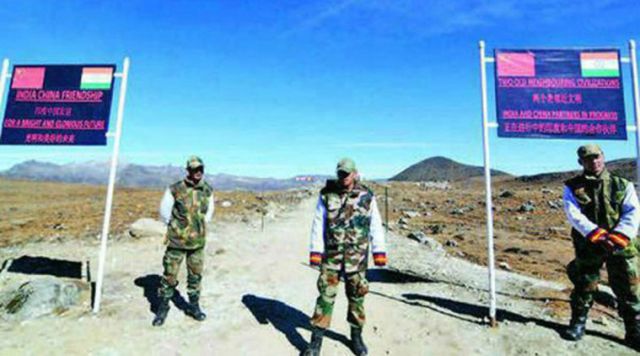
by admin | May 25, 2021 | Opinions
 By Admiral Arun Prakash (Retd),
By Admiral Arun Prakash (Retd),
Accustomed as we are to shrill hyperbole in India’s public discourse, the description of the tense Himalayan face-off as the “incident at Doklam” and its denouement as “expeditious disengagement of border personnel” by the Ministry of External Affairs came across as refreshing examples of phlegmatic understatement. The diplomatic finesse shown by India stood in stark contrast to the Chinese spokesperson’s gauche declaration that India had “pulled back all the trespassing personnel and equipment”.
Political pundits and diplomatic analysts are likely to spend days deciphering the hidden meanings underlying the Chinese conduct and dialectic, seen and heard during the past six weeks. The common man has, understandably, heaved a sigh of relief at the (short-term) resolution of a dire crisis; an eyeball-to-eyeball confrontation between two major military powers and nuclear-armed states.
The Chinese do not risk the outcome of a conflict on a single clash; they plan elaborate multiple strategies and the patient accumulation of small gains. Doklam was, by no means, India’s last confrontation with China and there is, thus, no cause whatsoever for our soldiers, diplomats and political leadership to become complacent — for four reasons.
Firstly, our 1962 military defeat was due to the egregious misreading of China’s intent by India’s political leadership. Fifty-five years on, clarity and resolve are still lacking vis-a-vis our strategic stance and policies towards an increasingly bellicose China.
This seeming diffidence is partly rooted in a fear of the unknown, our profound ignorance about this huge neighbour. We have neither created a substantive pool of Mandarin speakers, nor fostered many organisations dedicated to researching China’s history, culture, economy, industry and strategic thought. With bizarre perversity, we have been spurning the huge window, into China, that a willing and cooperative Taiwan has been offering to us, for years. We need to stop groping in the dark and create strategies to counter China’s long-term intentions.
Secondly, China, translating its enormous economic gains into coercive military power, expects neighbouring nations to voluntarily submit to Chinese hegemony. This is a clear echo of the distant past. In 416 BCE, when the mighty Athenian state overpowered the tiny island of Melos, it had delivered an ultimatum, using a similar chilling phraseology: “The strong do what they can, and the weak suffer what they must.”
Servile personalities like Philippine President Duterte have given China false illusions of grandeur and power by kowtowing for economic gains. These illusions have been reinforced by America’s aborted “pivot to Asia” and ineffectual “freedom of navigation” operations by US Navy. The artificial South China Sea islands are here to stay and China knows that possession is nine-points of law.
PLA Colonel Liu Mingfu’s 2010 book, “China Dream”, provides many pointers. It defines China’s national goal as to become “number one” in the world, but rejecting the “peaceful rise” thesis, it advocates a “military rise” along with its “economic rise”. A part of the “Chinese dream of national rejuvenation” is the establishment of a “unified global system”, or Empire, termed tianxia in Mandarin. Order, in this system, is maintained under the aegis of a hegemon state, which dominates by virtue of its acknowledged superiority.
According to former US Secretary of State Henry Kissinger, the Chinese have been shrewd practitioners of realpolitik and follow a strategic doctrine distinctly different from the rest of the world. Followers of the game of chess or “shatranj”, Indians think in terms of striking blows, decisive battles and finally checkmating or claiming total victory over the opponent.
The Chinese counterpart of shatranj is the game of “wei-qui”, based on “surrounding pieces” and “strategic encirclement”. Opponents seek empty spaces and building up of strength, surrounding and capturing opposing pieces. While chess encourages single-mindedness, wei-qui generates strategic flexibility. Let us learn to play wei-qui.
Thirdly, while patting ourselves on the back for deft diplomacy, let us not forget that we have had a close call. While our gallant armed forces could certainly have given a “bloody nose” (so eagerly sought by militant TV anchors) to the PLA on many fronts, a general war or even a limited clash would have been equally damaging to both nations and their economies.
Let us, also, remind ourselves that the PLA is undergirded by a military-industrial complex, established in the 1950s, which is a prolific producer of missiles, tanks, fighters, warships, submarines and ordnance. While the world has an inkling that the “Make in India” project is awaiting take-off, the feckless office of the Comptroller and Auditor General of India saw it fit to choose this juncture to reveal every single shortcoming in India’s half-full arsenal.
Avoiding knee-jerk responses, let us undertake long-term measures to ensure that our armed forces are always equipped and ready to fight a 30-day “intense war”. Let us also find ways to prevent statutory bodies like the CAG from endangering national security.
Finally, while the vision of China’s grandiose, “one-belt one road” (OBOR) may be impressive as well as intimidating, the project relies on ports, seaborne commerce and sea lanes. India’s non-participation in the project is already causing concern in Beijing. Chinese President Hu Jintao’s famous reference to the “Malacca dilemma”, which acknowledged the vulnerability of China’s seaborne trade and energy, was, no doubt, rooted in India’s dominant oceanic location and the possibility of trade warfare being waged by the Indian Navy. India must do everything to keep Hu Jintao’s nightmare alive.
(Admiral Arun Prakash served as the Chief of Naval Staff of the Indian Navy and Chairman, Chiefs of Staff Committee, from July 31, 2004, to October 31, 2006. The views expressed are personal. He can be contacted at arunp2810@yahoo.com)
—IANS





